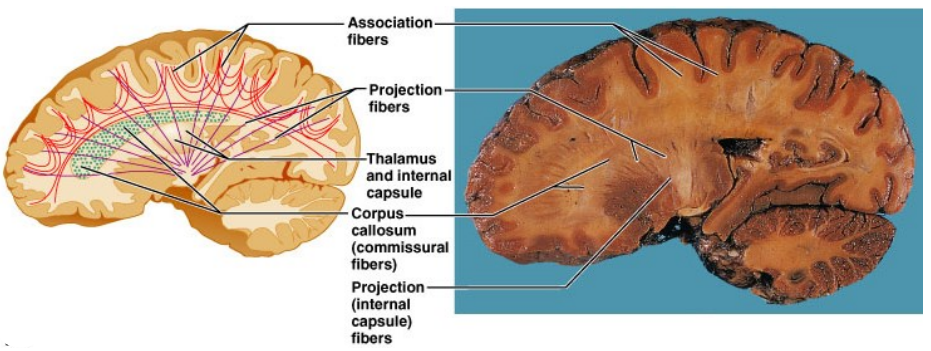1. CNS 2 Brain Anatomy
1/27
There's no tags or description
Looks like no tags are added yet.
Name | Mastery | Learn | Test | Matching | Spaced |
|---|
No study sessions yet.
28 Terms
What is the basic organisation of neuronal cells?
Cell body (soma): Large structure with central nucleus
Dendrites: Receive inputs from other neurones
Axons: Transmit impulses away from the cell body
Axon terminals: Form synapses with other neurones
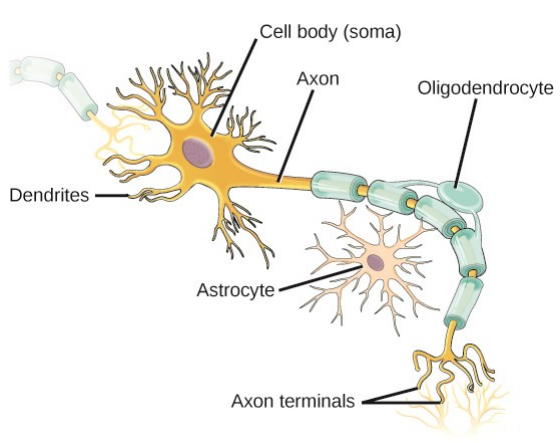
What are the main types of glial cells & their functions?
Astrocytes: Regulate the chemical environment of nerve cells
Oligodendrocytes: Form myelin sheaths around axons to ↑ impulse efficiency
Microglia: Primary immune cells of the CNS
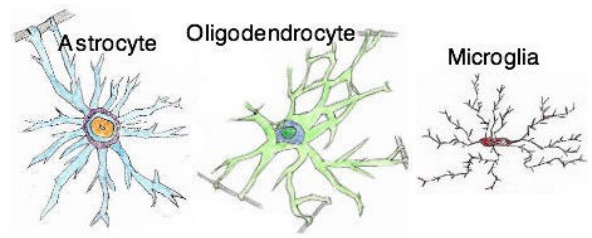
What are the main components involved in brain protection?
Skull: Supports facial structures & protects the brain
Meninges: 3 layers – dura mater, arachnoid mater, pia mater
Cerebrospinal fluid (CSF):
Made by choroid plexuses (capillaries + ependymal cells)
Formed via plasma filtration
Used to diagnose meningitis, bleeds, multiple sclerosis
Blood-brain barrier (BBB):
Tight junctions between brain capillary endothelial cells
Highly selective transport mechanisms
What are the key anatomical terms for the PNS & CNS?
PNS:
Ganglia: Neuronal cell bodies in PNS
Nerves: Axons in periphery
CNS:
Brain & spinal cord
Nuclei: Neuronal cell bodies in CNS
Tracts: Axons in CNS
What do rostral, caudal, dorsal & ventral mean in brain anatomy?
Rostral: Front
Caudal: Back
Dorsal: Top
Ventral: Bottom
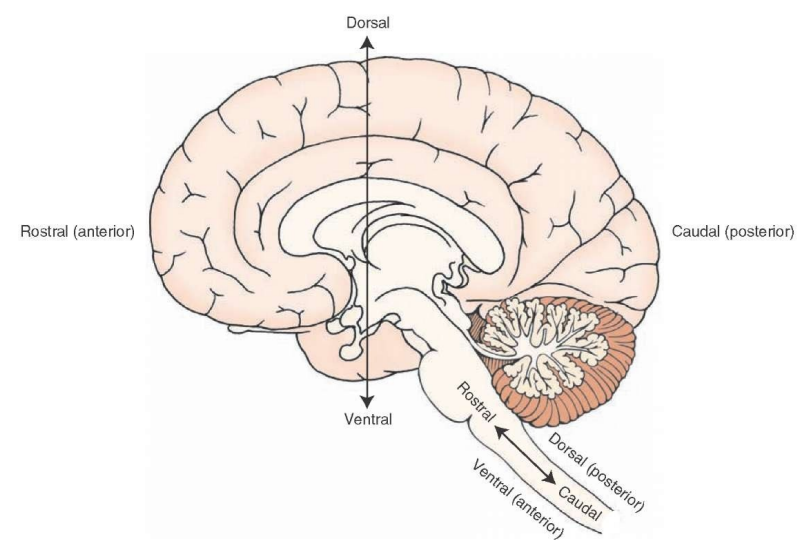
What are the main parts of the brain?
Brainstem: Midbrain, Pons, Medulla oblongata
Cerebellum
Diencephalon: Thalamus, Hypothalamus
Cerebrum: Two cerebral hemispheres
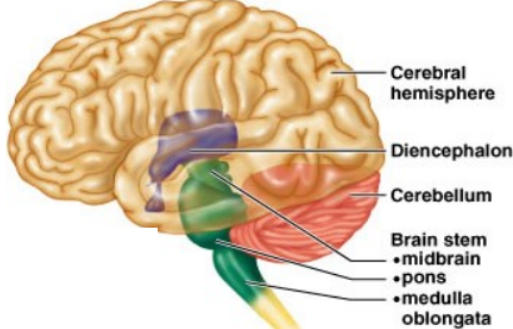
What are the functions of the medulla oblongata?
Controls autonomic functions: respiration, heart rate, BP, digestion
Controls movements via pyramidal tracts
Relays somatic sensory info to cortex & cerebellum
Regulates arousal & sleep
What are the functions of the medulla oblongata?
Controls autonomic functions: respiration, heart rate, BP, digestion
Controls movements via pyramidal tracts
Relays somatic sensory info to cortex & cerebellum
Regulates arousal & sleep
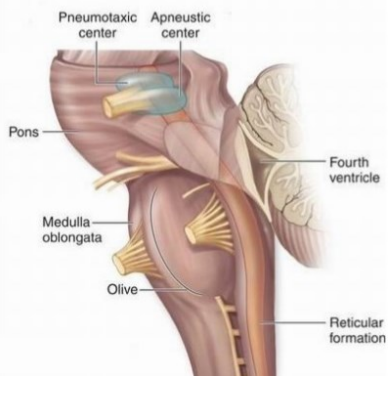
What are the functions of the pons?
Connects the cerebellum & cerebrum
Origin of cranial nerves, including Trigeminal (feeling in face, chewing, swallowing) & Facial (facial expressions)
Regulates breathing depth & frequency
Modulates brain activity through slow neurotransmitter systems
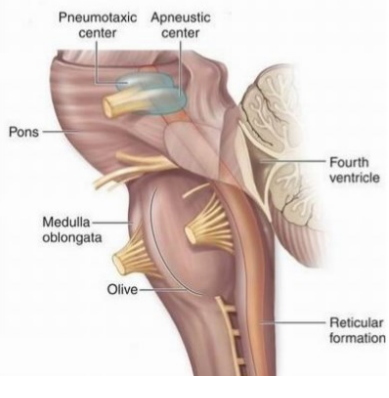
What are the functions of the midbrain?
Involved in vision, hearing, motor control, sleep/wake, arousal & temperature regulation
Contains dopaminergic nuclei (Substantia Nigra, Ventral Tegmental Area) that supply dopamine to the brain, regulating motor pathways & motivation
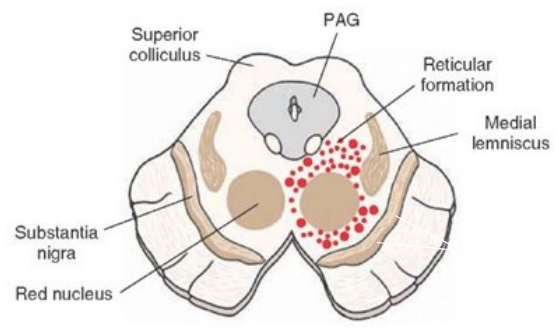
What are the functions of the cerebellum?
Regulates motor control, coordination, timing & motor learning
Involved in attention, language, fear & pleasure
Receives input from spinal cord & other brain areas
Loss of function causes coordination issues, dizziness, impaired speech
Linked to cognitive disorders like autism, schizophrenia & dyslexia
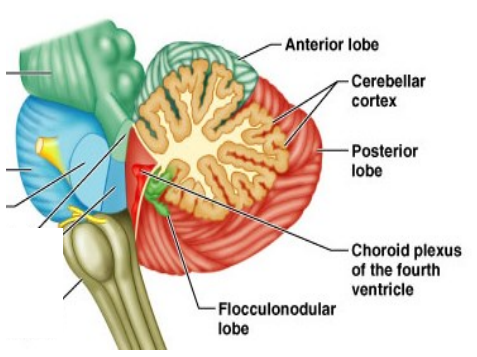
What are the components of the diencephalon?
Thalamus
Hypothalamus
Epithalamus (Pineal gland)
Subthalamus (Subthalamic nucleus)
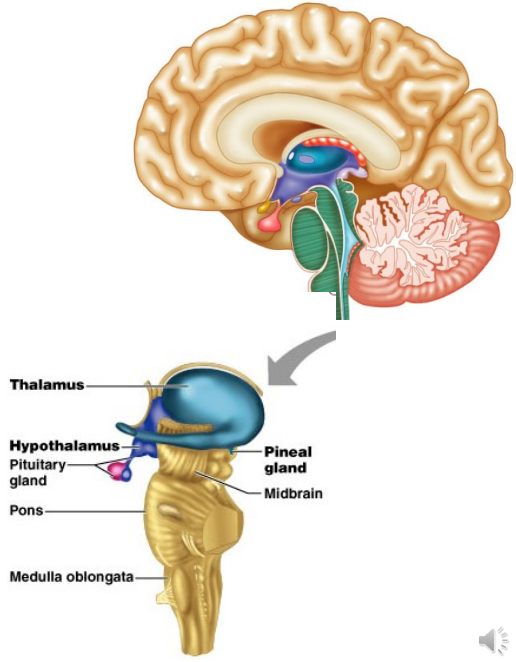
What are the functions and features of the thalamus?
Relays sensory signals (except olfactory) to cortex
Regulates sleep, wakefulness & consciousness
Composed of two lobes
Damage = coma, sensory/movement issues, sleepiness
Linked to disorders like bipolar, ADHD, autism

What are the functions and features of the hypothalamus?
Regulates temperature, hunger, thirst, & ANS
Controls endocrine system via pituitary
Manages emotions, behaviour, sleep-wake cycle
Maintains metabolism & circadian rhythm
Damage = hypothermia, lethargy, weight changes, stress
Linked to depression, bipolar, schizophrenia, hormonal issues

What are the functions and features of the subthalamus?
Small ventral anterior part of the diencephalon
Main component is the subthalamic nucleus
Connected to the basal ganglia region
What are the functions and features of the epithalamus?
Small dorsal part of the diencephalon
Contains the pineal gland, which produces melatonin at night to regulate sleep
Which neurological disorder is caused by the loss of neurones in the Substantia nigra?
Parkinson’s disease
What are the main components & functions of the basal ganglia?
Includes striatum, globus pallidus, nucleus accumbens, subthalamic nucleus, substantia nigra
Regulates motor function
Needs dopamine from substantia nigra
Nucleus accumbens = reward system
Impairment = addiction, depression, schizophrenia
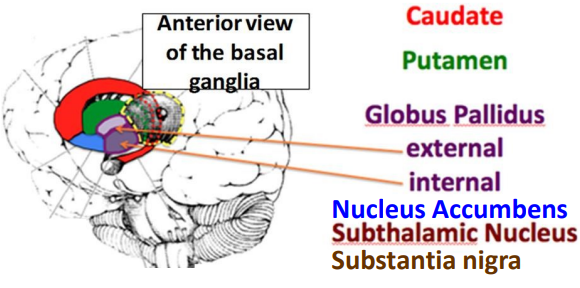
What are the roles of the basal ganglia & what happens when it's damaged?
Controls voluntary movement, habits, eye movement, cognition, emotion
Forms loops with cortex & thalamus for movement selection
Damage = tremors, posture issues, difficulty starting movement
Parkinson’s: ↓ dopamine = movement problems
Huntington’s: striatum loss = uncontrolled movement
Dyskinesia: often drug-induced
What are the functions of the hippocampus & what happens if it's damaged?
In medial temporal lobe, part of limbic system
Roles: memory consolidation, spatial navigation
Damage = memory loss, disorientation
Linked to Alzheimer’s, depression, bipolar, schizophrenia
What are the key components & functions of the cerebrum?
Largest brain region
Cerebral cortex (outer gray matter):
2–4 mm thick
Neuronal cell bodies, dendrites, unmyelinated axons
White matter: myelinated axons beneath the cortex
Deep gray matter: includes basal ganglia
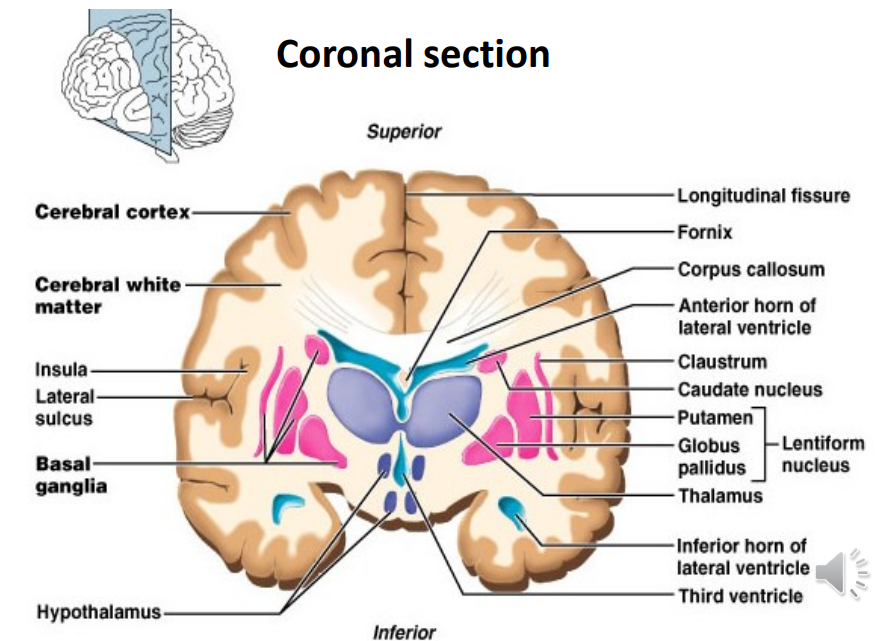
How are the cerebral hemispheres structured & divided?
Divided into right & left by longitudinal fissure
Central sulcus separates frontal & parietal lobes
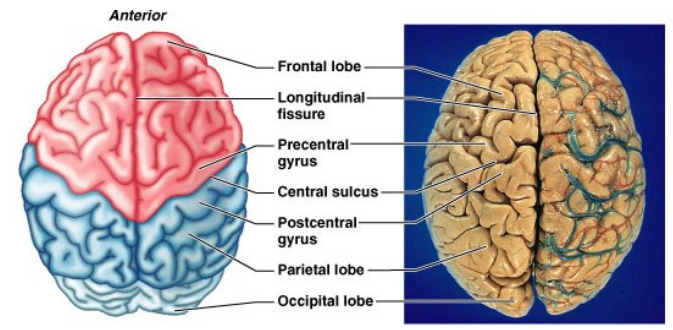
What are the functions of the parietal lobe & its sensory areas?
Posterior to central sulcus
Detects, localizes & interprets sensory input
Handles spatial attention & visual-spatial processing
Damage = trouble recognizing or locating objects/body parts
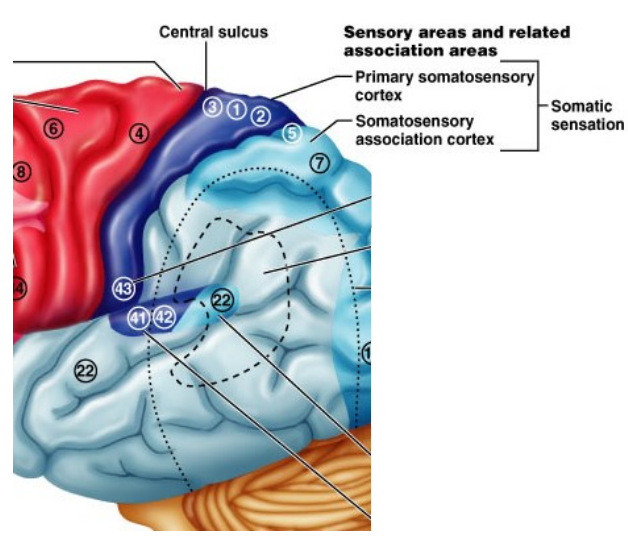
What are the functions of the occipital & temporal lobes?
Occipital lobe – processes vision
Damage → hallucinations, blindness, visual issues
Temporal lobe – processes hearing & language
Damage → impaired language understanding, memory loss
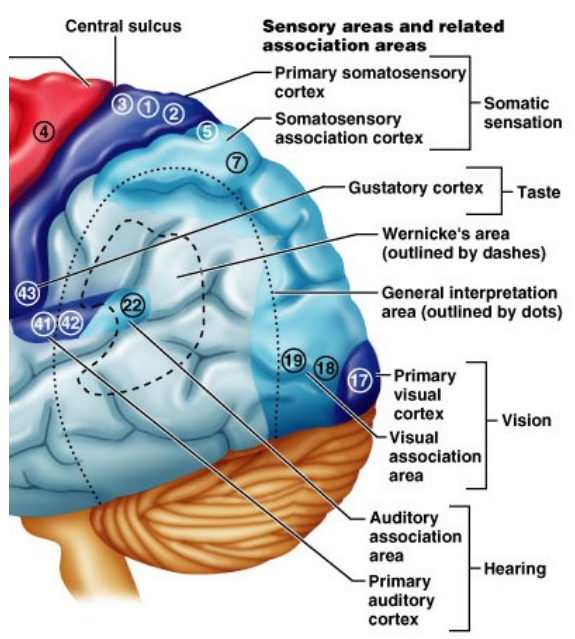
What does fMRI show during speaking & hearing?
Functional magnetic resonance imaging (fMRI)
Measures brain activity via blood flow
Cerebral cortex of person speaking & hearing
Activity in frontal lobe (speaking)
Activity in temporal lobe (hearing)
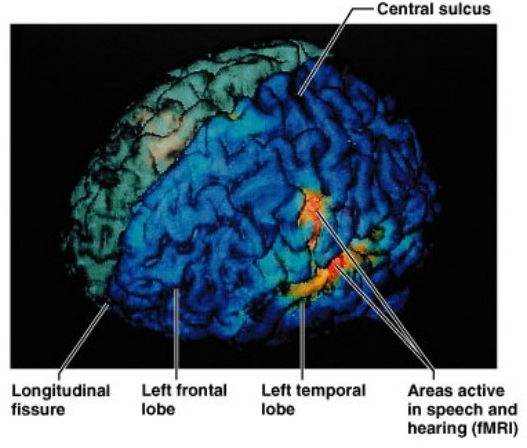
What are the main motor functions of the frontal lobe?
Coordinates voluntary movement of skeletal muscles
Coordinates planning of voluntary movement
Specialized motor speech function
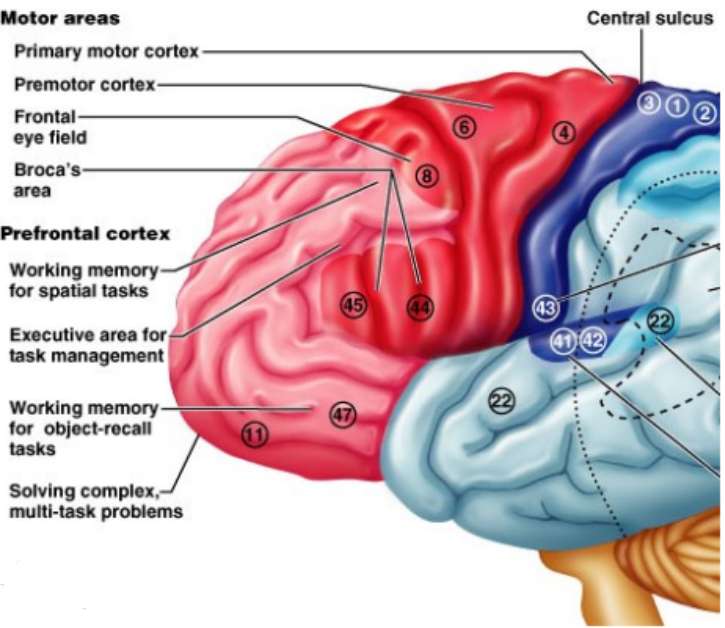
What are the functions of the prefrontal cortex?
Cognition & learning
Executive functioning
Social skills & mood
Mental flexibility & empathy
Conscience & judgment
Personality & impulse control
Long-term planning
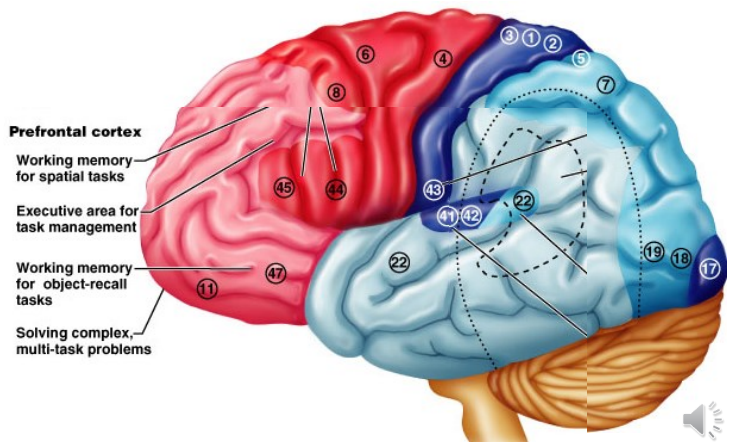
What is the role of cerebral white matter & its fiber types?
Enables communication between:
Cortical areas
Cortex & brain stem/spinal cord
Mostly myelinated axons in tracts:
Commissures – connect R & L hemispheres (e.g. corpus callosum)
Association fibers – connect parts of the same hemisphere
Projection fibers – run vertically to/from cerebral cortex
